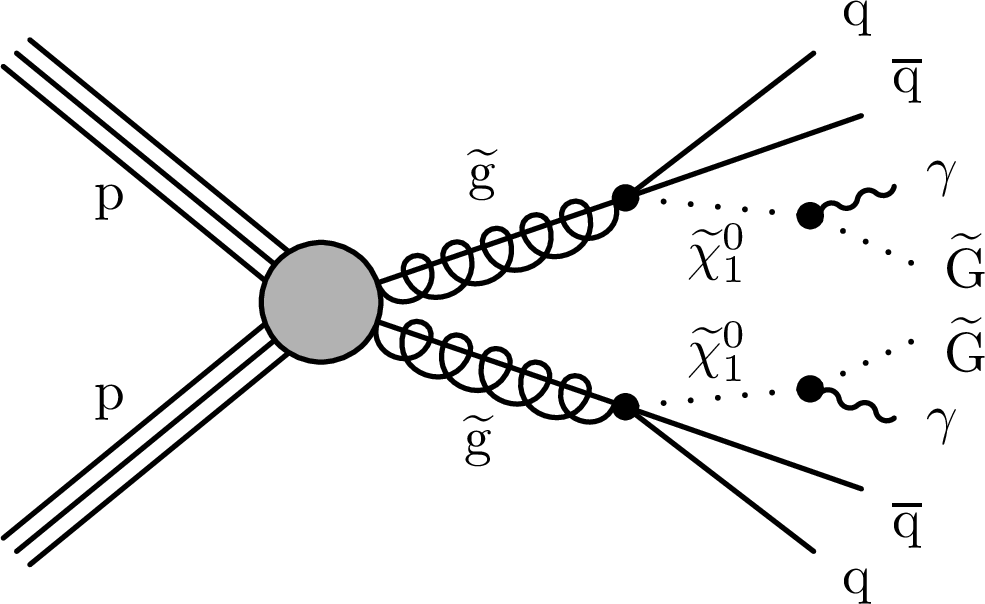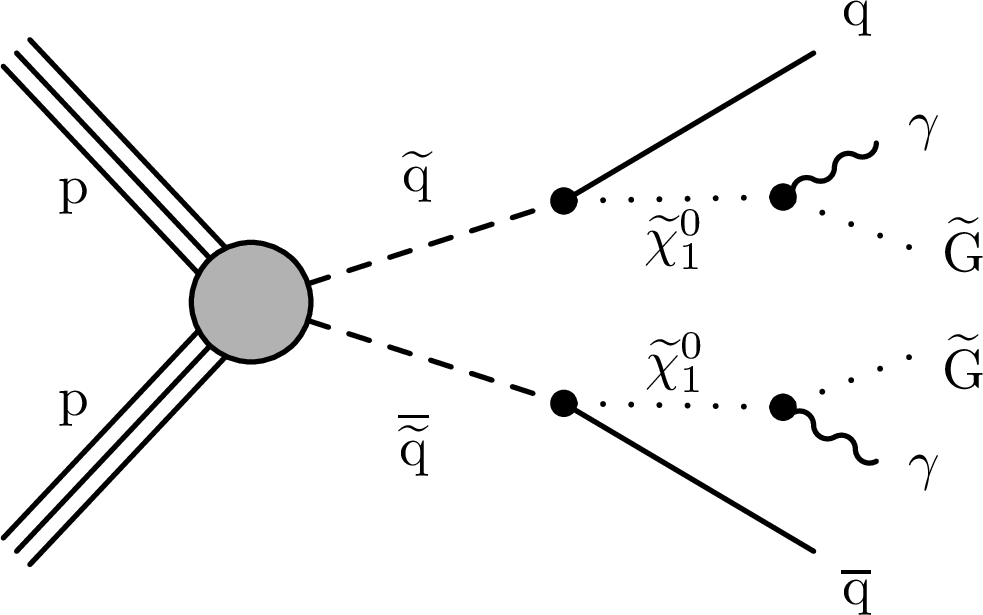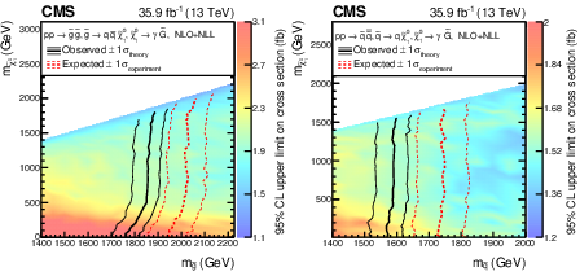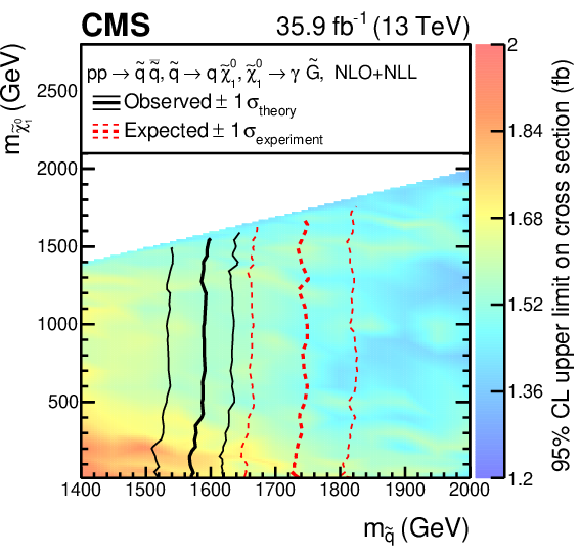

Compact Muon Solenoid
LHC, CERN
| CMS-SUS-17-011 ; CERN-EP-2019-040 | ||
| Search for supersymmetry in final states with photons and missing transverse momentum in proton-proton collisions at 13 TeV | ||
| CMS Collaboration | ||
| 17 March 2019 | ||
| JHEP 06 (2019) 143 | ||
| Abstract: Results are reported for a search for supersymmetry in final states with photons and missing transverse momentum in proton-proton collisions at the LHC. The data sample corresponds to an integrated luminosity of 35.9 fb$^{-1}$ collected at a center-of-mass energy of 13 TeV using the CMS detector. The results are interpreted in the context of models of gauge-mediated supersymmetry breaking. Production cross section limits are set on gluino and squark pair production in this framework. Gluino masses below 1.86 TeV and squark masses below 1.59 TeV are excluded at 95% confidence level. | ||
| Links: e-print arXiv:1903.07070 [hep-ex] (PDF) ; CDS record ; inSPIRE record ; CADI line (restricted) ; | ||
| Figures | |

png pdf |
Figure 1:
Diagrams showing the production of signal events in the collision of two protons (p). In gluino (${\mathrm {\tilde{g}}}$) pair production in the T5gg simplified model (left), the gluino decays to a quark-antiquark pair (${\mathrm {q}} {\overline {\mathrm {q}}}$) and a neutralino (${\tilde{\chi}^{0}_{1}}$). In squark (${\mathrm {\tilde{q}}}$) pair production in the T6gg simplified model (right), the squark decays to a quark and a neutralino. In both cases, the neutralino subsequently decays to a photon (${\gamma}$) and a gravitino (${\mathrm{\tilde{G}}}$). |

png pdf |
Figure 1-a:
Diagram showing the gluino (${\mathrm {\tilde{g}}}$) pair production in the collision of two protons (p), in the T5gg simplified model. The gluino decays to a quark-antiquark pair (${\mathrm {q}} {\overline {\mathrm {q}}}$) and a neutralino (${\tilde{\chi}^{0}_{1}}$). The neutralino subsequently decays to a photon (${\gamma}$) and a gravitino (${\mathrm{\tilde{G}}}$). |

png pdf |
Figure 1-b:
Diagram showing the squark (${\mathrm {\tilde{q}}}$) pair production in the collision of two protons (p), in the T6gg simplified model. The squark decays to a quark and a neutralino. The neutralino subsequently decays to a photon (${\gamma}$) and a gravitino (${\mathrm{\tilde{G}}}$). |

png pdf |
Figure 2:
The top panel shows the observed ${{p_{\mathrm {T}}} ^\text {miss}}$ distribution in data (black points) and predicted background distributions prior to the fit. The vertical line marks the boundary between the validation region ($ {{p_{\mathrm {T}}} ^\text {miss}} < $ 100 GeV) and the signal region ($ {{p_{\mathrm {T}}} ^\text {miss}} > $ 100 GeV). The last bin includes all events with $ {{p_{\mathrm {T}}} ^\text {miss}} > $ 250 GeV. The QCD background is shown in red, the EWK background is shown in blue, and the $ {\mathrm {Z}} {\gamma} {\gamma}$ background is shown in green. The ${{p_{\mathrm {T}}} ^\text {miss}}$ distribution shown in pink (purple) corresponds to the T5gg simplified model with $m_{{\mathrm {\tilde{g}}}}= $ 1700 (2000) GeV and $m_{{\tilde{\chi}^{0}_{1}}} = $ 1000 GeV. The bottom panel shows the ratio of observed events to the expected background. The error bars on the ratio correspond to the statistical uncertainty in the number of observed events. The shaded region corresponds to the total uncertainty in the background estimate. |

png pdf |
Figure 3:
The 95% confidence level upper limits on the gluino (left) and squark (right) pair production cross sections as a function of gluino or squark and neutralino masses. The contours show the observed and expected exclusions assuming the NLO+NLL cross sections, with their one standard deviation uncertainties. |

png pdf |
Figure 3-a:
The 95% confidence level upper limits on the gluino pair production cross sections as a function of gluino and neutralino masses. The contours show the observed and expected exclusions assuming the NLO+NLL cross sections, with their one standard deviation uncertainties. |

png pdf |
Figure 3-b:
The 95% confidence level upper limits on the squark pair production cross sections as a function of squark and neutralino masses. The contours show the observed and expected exclusions assuming the NLO+NLL cross sections, with their one standard deviation uncertainties. |
| Tables | |

png pdf |
Table 1:
Event yield and statistical and systematic uncertainties (in numbers of events) in the QCD background estimation for each signal ${{p_{\mathrm {T}}} ^\text {miss}}$ bin. |

png pdf |
Table 2:
Number of expected background and observed data events in the signal region prior to the fit defined in the text. The uncertainty in each expected background yield includes the statistical uncertainty and all of the systematic uncertainties described in Section 5 added in quadrature. |
| Summary |
|
The results of a search for general gauge-mediated supersymmetry breaking in proton-proton collisions with two photons and missing transverse momentum in the final state are reported. The analysis was performed using data corresponding to 35.9 fb$^{-1}$ of integrated luminosity, recorded with the CMS detector in 2016 at a proton-proton center-of-mass energy of 13 TeV. An excess of events corresponding to 2.4 standard deviations is observed. Limits are determined on the masses of supersymmetric particles in two simplified models using data-driven background estimation methods and NLO+NLL signal cross section calculations. In both models, the next-to-lightest supersymmetric particle is the neutralino, which decays with a 100% branching fraction to a photon and a gravitino, the lightest supersymmetric particle. The first simplified model assumes gluino pair production, with each gluino decaying to a neutralino and quarks. The second simplified model assumes squark pair production, with each squark decaying to a quark and a neutralino. The expected limits on gluino and squark masses, for the respective models, are 2.02 and 1.74 TeV at 95% confidence level. This is an increase in sensitivity of more than 300 GeV for each model with respect to the analysis performed with 2.3 fb$^{-1}$ of integrated luminosity collected using the CMS detector in 2015. The observed exclusions are for gluino masses less than 1.86 TeV and squark masses less than 1.59 TeV, where the difference between the expected and observed exclusions is driven by the excess observed in the data. The analysis described in this paper improves the observed limits by 210 GeV for gluino masses and 220 GeV for squark masses with respect to the previous CMS result. |
| References | ||||
| 1 | C. R. Nappi and B. A. Ovrut | Supersymmetric extension of the SU(3)$ \times $SU(2)$ \times $U(1) model | PLB 113 (1982) 175 | |
| 2 | M. Dine and W. Fischler | A phenomenological model of particle physics based on supersymmetry | PLB 110 (1982) 227 | |
| 3 | L. Alvarez-Gaum\'e, M. Claudson, and M. B. Wise | Low-energy supersymmetry | Nuc. Phys. B 207 (1982) 96 | |
| 4 | M. Dine and A. E. Nelson | Dynamical supersymmetry breaking at low-energies | PRD 48 (1993) 1277 | hep-ph/9303230 |
| 5 | M. Dine, A. E. Nelson, and Y. Shirman | Low-energy dynamical supersymmetry breaking simplified | PRD 51 (1995) 1362 | hep-ph/9408384 |
| 6 | M. Dine, A. E. Nelson, Y. Nir, and Y. Shirman | New tools for low-energy dynamical supersymmetry breaking | PRD 53 (1996) 2658 | hep-ph/9507378 |
| 7 | R. Barbieri and G. F. Giudice | Upper bounds on supersymmetric particle masses | NPB 306 (1988) 63 | |
| 8 | S. Dimopoulos, G. F. Giudice, and A. Pomarol | Dark matter in theories of gauge-mediated supersymmetry breaking | PLB 389 (1996) 37 | hep-ph/9607225 |
| 9 | S. P. Martin | Generalized messengers of supersymmetry breaking and the sparticle mass spectrum | PRD 55 (1997) 3177 | hep-ph/9608224 |
| 10 | E. Poppitz and S. P. Trivedi | Some remarks on gauge-mediated supersymmetry breaking | PLB 401 (1997) 38 | hep-ph/9703246 |
| 11 | P. Meade, N. Seiberg, and D. Shih | General gauge mediation | Prog. Theor. Phys. Suppl. 177 (2009) 143 | 0801.3278 |
| 12 | M. Buican, P. Meade, N. Seiberg, and D. Shih | Exploring general gauge mediation | JHEP 03 (2009) 016 | 0812.3668 |
| 13 | S. Abel, M. J. Dolan, J. Jaeckel, and V. V. Khoze | Phenomenology of pure general gauge mediation | JHEP 12 (2009) 001 | 0910.2674 |
| 14 | L. M. Carpenter, M. Dine, G. Festuccia, and J. D. Mason | Implementing general gauge mediation | PRD 79 (2009) 035002 | 0805.2944 |
| 15 | T. T. Dumitrescu, Z. Komargodski, N. Seiberg, and D. Shih | General messenger gauge mediation | JHEP 05 (2010) 96 | 1003.2661 |
| 16 | G. R. Farrar and P. Fayet | Phenomenology of the production, decay, and detection of new hadronic states associated with supersymmetry | PLB 76 (1978) 37 | |
| 17 | CMS Collaboration | Search for supersymmetry in events with photons and missing transverse energy in pp collisions at 13 TeV | PLB 769 (2017) 391 | 1611.06604 |
| 18 | ATLAS Collaboration | Search for supersymmetry in a final state containing two photons and missing transverse momentum in $ \sqrt{s} = $ 13 TeV pp collisions at the LHC using the ATLAS detector | EPJC 76 (2016) 517 | 1606.09150 |
| 19 | ATLAS Collaboration | Search for photonic signatures of gauge-mediated supersymmetry in 13 TeV pp collisions with the ATLAS detector | PRD 97 (2018) 092006 | 1802.03158 |
| 20 | N. Arkani-Hamed et al. | MARMOSET: The path from LHC data to the new standard model via on-shell effective theories | hep-ph/0703088 | |
| 21 | J. Alwall, P. C. Schuster, and N. Toro | Simplified models for a first characterization of new physics at the LHC | PRD 79 (2009) 075020 | 0810.3921 |
| 22 | J. Alwall, M.-P. Le, M. Lisanti, and J. G. Wacker | Model-independent jets plus missing energy searches | PRD 79 (2009) 015005 | 0809.3264 |
| 23 | D. Alves et al. | Simplified models for LHC new physics searches | JPG 39 (2012) 105005 | 1105.2838 |
| 24 | CMS Collaboration | Interpretation of searches for supersymmetry with simplified models | PRD 88 (2013) 052017 | CMS-SUS-11-016 1301.2175 |
| 25 | CMS Collaboration | The CMS experiment at the CERN LHC | JINST 3 (2008) S08004 | CMS-00-001 |
| 26 | CMS Collaboration | The CMS trigger system | JINST 12 (2017) P01020 | CMS-TRG-12-001 1609.02366 |
| 27 | J. Alwall et al. | The automated computation of tree-level and next-to-leading order differential cross sections, and their matching to parton shower simulations | JHEP 07 (2014) 079 | 1405.0301 |
| 28 | T. Sjostrand, S. Mrenna, and P. Z. Skands | A brief introduction to PYTHIA 8.1 | CPC 178 (2008) 852 | 0710.3820 |
| 29 | CMS Collaboration | Event generator tunes obtained from underlying event and multiparton scattering measurements | EPJC 76 (2016) 155 | 1512.00815v2 |
| 30 | NNPDF Collaboration | Parton distributions for the LHC Run II | JHEP 04 (2015) 040 | 1410.8849 |
| 31 | GEANT4 Collaboration | GEANT4--a simulation toolkit | NIMA 506 (2003) 250 | |
| 32 | CMS Collaboration | The fast simulation of the CMS detector at LHC | J. Phys. Conf. Ser. 331 (2011) 032049 | |
| 33 | A. Giammanco | The fast simulation of the CMS experiment | J. Phys. Conf. Ser. 513 (2014) 022012 | |
| 34 | W. Beenakker, R. Hopker, M. Spira, and P. M. Zerwas | Squark and gluino production at hadron colliders | NPB 492 (1997) 51 | hep-ph/9610490 |
| 35 | A. Kulesza and L. Motyka | Threshold resummation for squark-antisquark and gluino-pair production at the LHC | PRL 102 (2009) 111802 | 0807.2405 |
| 36 | A. Kulesza and L. Motyka | Soft gluon resummation for the production of gluino-gluino and squark-antisquark pairs at the LHC | PRD 80 (2009) 095004 | 0905.4749 |
| 37 | W. Beenakker et al. | Soft-gluon resummation for squark and gluino hadroproduction | JHEP 12 (2009) 041 | 0909.4418 |
| 38 | W. Beenakker et al. | Squark and gluino hadroproduction | Int. J. Mod. Phys. A 26 (2011) 2637 | 1105.1110 |
| 39 | C. Borschensky et al. | Squark and gluino production cross sections in pp collisions at $ \sqrt{s} = $ 13, 14, 33 and 100 TeV | EPJC 74 (2014) 3174 | 1407.5066 |
| 40 | CMS Collaboration | Particle-flow reconstruction and global event description with the CMS detector | JINST 12 (2017) P10003 | CMS-PRF-14-001 1706.04965 |
| 41 | CMS Collaboration | Performance of photon reconstruction and identification with the CMS detector in proton-proton collisions at $ \sqrt{s} = $ 8 TeV | JINST 10 (2015) P08010 | CMS-EGM-14-001 1502.02702 |
| 42 | CMS Collaboration | CMS luminosity measurements for the 2016 data taking period | CMS-PAS-LUM-17-001 | CMS-PAS-LUM-17-001 |
| 43 | T. Junk | Confidence level computation for combining searches with small statistics | NIMA 434 (1999) 435 | hep-ex/9902006 |
| 44 | A. L. Read | Presentation of search results: the $ CL_s $ technique | JPG 28 (2002) 2693 | |
| 45 | ATLAS and CMS Collaborations | Procedure for the LHC Higgs boson search combination in Summer 2011 | CMS-NOTE-2011-005 | |
| 46 | G. Cowan, K. Cranmer, E. Gross, and O. Vitells | Asymptotic formulae for likelihood-based tests of new physics | EPJC 71 (2011) 1554 | 1007.1727 |

|
Compact Muon Solenoid LHC, CERN |

|

|

|

|

|

|